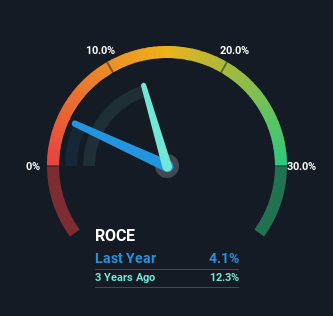- United States
- /
- Chemicals
- /
- NYSE:SCL
There Are Reasons To Feel Uneasy About Stepan's (NYSE:SCL) Returns On Capital
If we want to find a potential multi-bagger, often there are underlying trends that can provide clues. Firstly, we'll want to see a proven return on capital employed (ROCE) that is increasing, and secondly, an expanding base of capital employed. Put simply, these types of businesses are compounding machines, meaning they are continually reinvesting their earnings at ever-higher rates of return. However, after investigating Stepan (NYSE:SCL), we don't think it's current trends fit the mold of a multi-bagger.
Return On Capital Employed (ROCE): What Is It?
For those that aren't sure what ROCE is, it measures the amount of pre-tax profits a company can generate from the capital employed in its business. Analysts use this formula to calculate it for Stepan:
Return on Capital Employed = Earnings Before Interest and Tax (EBIT) ÷ (Total Assets - Current Liabilities)
0.041 = US$72m ÷ (US$2.4b - US$629m) (Based on the trailing twelve months to March 2024).
Therefore, Stepan has an ROCE of 4.1%. Ultimately, that's a low return and it under-performs the Chemicals industry average of 8.8%.
View our latest analysis for Stepan

Above you can see how the current ROCE for Stepan compares to its prior returns on capital, but there's only so much you can tell from the past. If you'd like to see what analysts are forecasting going forward, you should check out our free analyst report for Stepan .
What Does the ROCE Trend For Stepan Tell Us?
In terms of Stepan's historical ROCE movements, the trend isn't fantastic. Around five years ago the returns on capital were 11%, but since then they've fallen to 4.1%. Given the business is employing more capital while revenue has slipped, this is a bit concerning. This could mean that the business is losing its competitive advantage or market share, because while more money is being put into ventures, it's actually producing a lower return - "less bang for their buck" per se.
The Bottom Line
We're a bit apprehensive about Stepan because despite more capital being deployed in the business, returns on that capital and sales have both fallen. In spite of that, the stock has delivered a 2.0% return to shareholders who held over the last five years. Regardless, we don't like the trends as they are and if they persist, we think you might find better investments elsewhere.
If you want to continue researching Stepan, you might be interested to know about the 3 warning signs that our analysis has discovered.
While Stepan isn't earning the highest return, check out this free list of companies that are earning high returns on equity with solid balance sheets.
New: Manage All Your Stock Portfolios in One Place
We've created the ultimate portfolio companion for stock investors, and it's free.
• Connect an unlimited number of Portfolios and see your total in one currency
• Be alerted to new Warning Signs or Risks via email or mobile
• Track the Fair Value of your stocks
Have feedback on this article? Concerned about the content? Get in touch with us directly. Alternatively, email editorial-team (at) simplywallst.com.
This article by Simply Wall St is general in nature. We provide commentary based on historical data and analyst forecasts only using an unbiased methodology and our articles are not intended to be financial advice. It does not constitute a recommendation to buy or sell any stock, and does not take account of your objectives, or your financial situation. We aim to bring you long-term focused analysis driven by fundamental data. Note that our analysis may not factor in the latest price-sensitive company announcements or qualitative material. Simply Wall St has no position in any stocks mentioned.
About NYSE:SCL
Stepan
Produces and sells specialty and intermediate chemicals to other manufacturers for use in various end products worldwide.
Undervalued average dividend payer.
Similar Companies
Market Insights
Community Narratives



